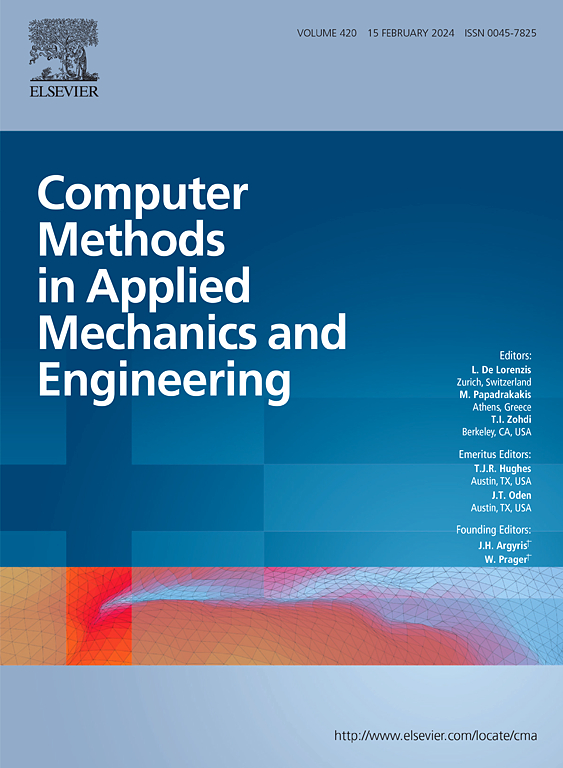Center manifold reduction of geometrically nonlinear beams: From 3D to 1D models
IF 7.3
1区 工程技术
Q1 ENGINEERING, MULTIDISCIPLINARY
Computer Methods in Applied Mechanics and Engineering
Pub Date : 2025-07-31
DOI:10.1016/j.cma.2025.118242
引用次数: 0
Abstract
This paper presents a novel center manifold-based approach for reducing the geometrically nonlinear three-dimensional continuum description of beam structures to efficient one-dimensional models. The beam considered is composed of hyperelastic material and features uniform cross-sectional geometry and material properties along its axial line. While Mielke previously proved that Saint-Venant’s solution resides within a twelve-dimensional center manifold, its construction for nonlinear dimensional-reduction of beams remains unexplored. This study presents the first explicit construction of the center manifold by approximating the warping field, sectional strains, and one-dimensional equilibrium equations as polynomials of the six stress resultant components, enabling dimensional reduction for beams undergoing geometrically nonlinear deformations. The method begins by decomposing beam kinematics into rigid-section motion and a warping field. A finite element semi-discretization of the cross-section is employed, and Hamilton’s variational principle yields equilibrium equations as nonlinear ordinary differential equations along the beam’s axial coordinate, enabling center manifold reduction. A critical challenge arises from the kinematic decomposition, requiring two interdependent mappings: sectional strains and warping field as nonlinear functions of stress resultants. Unlike conventional center manifold methods, which use a single set of invariance equations, this approach demands two distinct, coupled invariance equations. Additionally, the non-uniqueness of the kinematic decomposition leads to inherently singular cohomological equations, differing from traditional center manifold reduction. To address these challenges, four key advancements are proposed: (1) Two coupled set of invariance equations are established: one ensures sectional strains and warping fields satisfy three-dimensional equilibrium, and the other ensures the composed mapping for stress resultants reduces to the identity mapping. (2) The left- and right-null spaces of the cohomological equations, arising from non-unique kinematic decomposition, are rigorously identified, ensuring solution existence. (3) Uniqueness of compliance and warping matrices is established via energetic analysis of the system’s Hamiltonian, guaranteeing symmetry in higher-order compliance matrices. (4) Distributed functions of loads are reformulated as differential equations, transforming inhomogeneous systems into augmented homogeneous ones for dimensional reduction. Finally, the reduced-order one-dimensional beam model is solved using a mixed finite element formulation to enforce complementary-energy-based nonlinear constitutive laws derived from the center manifold reduction. Numerical examples validate the accuracy and computational efficiency of the proposed method, demonstrating its capability to capture geometric nonlinearities in beams with complex cross-sections, heterogeneous materials, initial curvatures, and distributed loading conditions.
几何非线性梁的中心流形缩减:从3D到1D模型
本文提出了一种新的基于中心流形的方法,将梁结构的几何非线性三维连续体描述简化为有效的一维模型。所考虑的梁由超弹性材料组成,沿其轴线具有均匀的横截面几何形状和材料特性。虽然Mielke先前证明了Saint-Venant的解存在于一个12维中心流形中,但它对于梁的非线性降维的构造仍未被探索。本研究通过将翘曲场、截面应变和一维平衡方程近似为六个应力合成分量的多项式,提出了中心流形的第一个显式结构,使经历几何非线性变形的梁能够减小尺寸。该方法首先将梁的运动学分解为刚性截面运动和翘曲场。采用截面的有限元半离散化,Hamilton变分原理将平衡方程转化为沿梁轴向坐标的非线性常微分方程,使中心流形简化。一个关键的挑战来自运动学分解,需要两个相互依赖的映射:截面应变和翘曲场作为应力结果的非线性函数。传统的中心流形方法只使用一组不变性方程,而这种方法需要两个不同的、耦合的不变性方程。此外,运动分解的非唯一性导致了固有的奇异上同调方程,不同于传统的中心流形约简。针对这些挑战,本文提出了以下四个关键进展:(1)建立了两组耦合的不变性方程:一组保证截面应变和翘曲场满足三维平衡,另一组保证应力结果的组合映射简化为恒等映射。(2)对由非唯一运动分解引起的上同调方程的左零空间和右零空间进行了严格的辨识,保证了解的存在性。(3)通过对系统哈密顿量的能量分析,建立了柔度矩阵和翘曲矩阵的唯一性,保证了高阶柔度矩阵的对称性。(4)将荷载的分布函数重新表述为微分方程,将非齐次系统转化为增广齐次系统进行降维。最后,使用混合有限元公式求解了降阶一维梁模型,以执行由中心流形约简导出的基于互补能量的非线性本构律。数值算例验证了该方法的准确性和计算效率,证明了该方法能够捕获具有复杂截面、非均质材料、初始曲率和分布载荷条件的梁的几何非线性。
本文章由计算机程序翻译,如有差异,请以英文原文为准。
求助全文
约1分钟内获得全文
求助全文
来源期刊
CiteScore
12.70
自引率
15.30%
发文量
719
审稿时长
44 days
期刊介绍:
Computer Methods in Applied Mechanics and Engineering stands as a cornerstone in the realm of computational science and engineering. With a history spanning over five decades, the journal has been a key platform for disseminating papers on advanced mathematical modeling and numerical solutions. Interdisciplinary in nature, these contributions encompass mechanics, mathematics, computer science, and various scientific disciplines. The journal welcomes a broad range of computational methods addressing the simulation, analysis, and design of complex physical problems, making it a vital resource for researchers in the field.

 求助内容:
求助内容: 应助结果提醒方式:
应助结果提醒方式:


